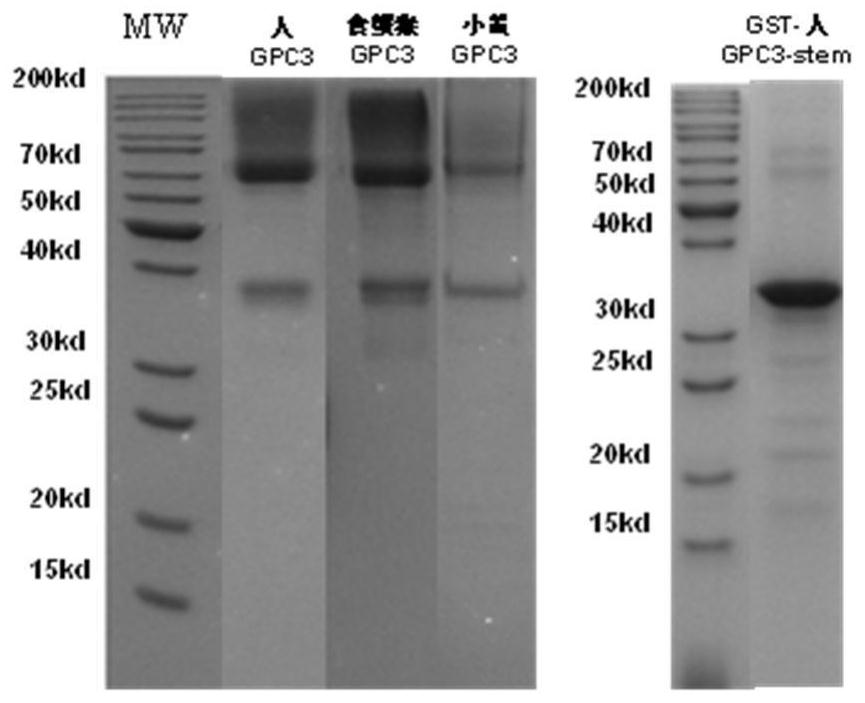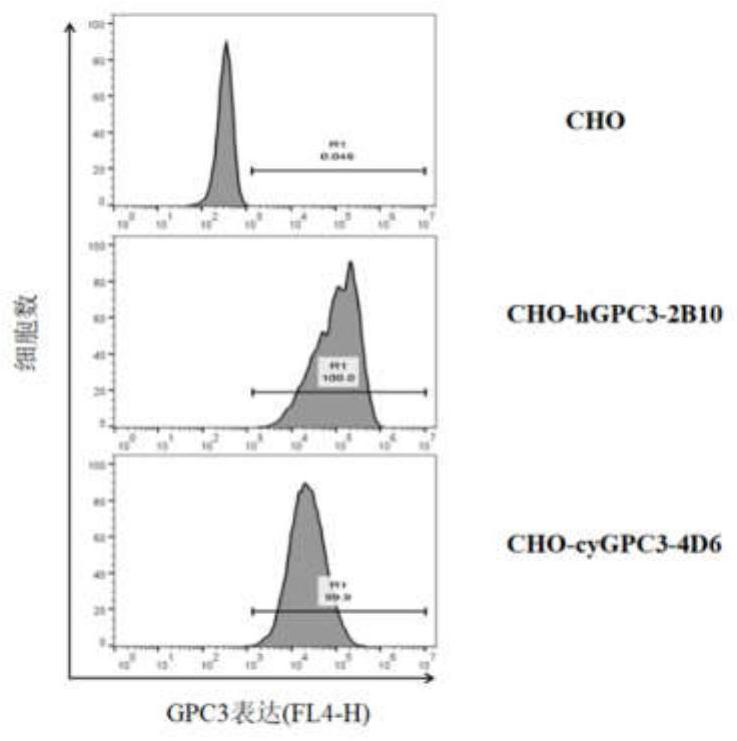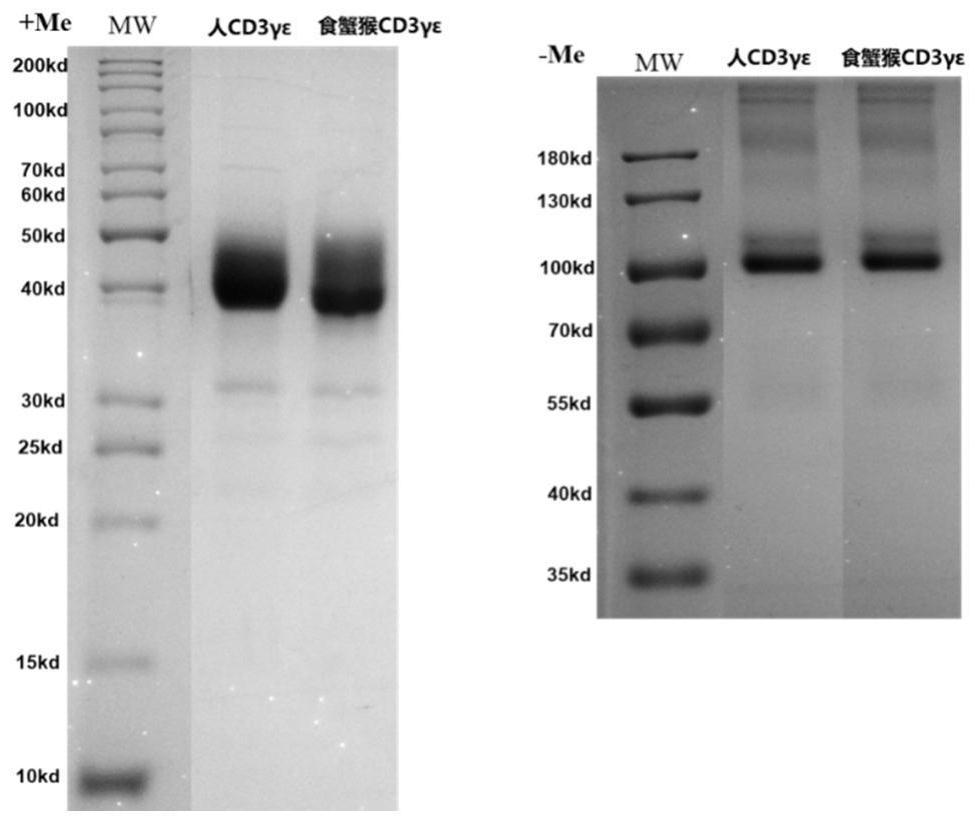Development and application of novel tumor adapter therapeutic drug
A technology of sequence and antigen, applied in the field of development and application of novel tumor-connector therapeutic drugs
- Summary
- Abstract
- Description
- Claims
- Application Information
AI Technical Summary
Problems solved by technology
Method used
Image
Examples
Embodiment 1
[0248] Example 1: Antigen expression and construction of stably transfected cells
[0249] Using human GPC3 (Sino biological, HG10088) as a template, amplify the extracellular region of human GPC3 (25-563), transfect HEK293E cells, and express the recombinant human GPC3 protein (SEQ ID NO. 1), or the near-membrane sequence ( aa 524-563) was inserted into the EcoRI site of pGEX3X vector by Gibson assembly method, the plasmid was transfected into Escherichia coli BL21 (DE3), and IPTG induced expression and purification to obtain GST-human GPC3 stem recombinant protein (SEQ ID NO. 2). The GST-cynomolgus monkey GPC3 stem recombinant protein (SEQ ID NO. 3) and the GST-mouse GPC3 stem recombinant protein (SEQ ID NO. 4) were expressed in the same way. figure 1 Non-reducing SDS-PAGE results of GPC3 recombinant protein are shown.
[0250] The Lenti vector and packaging plasmid (Genecoepia) containing the full-length sequence of human and rhesus monkey GPC3 were co-transfected into HEK...
Embodiment 2
[0252] Example 2. Animal immunization and preparation of GPC3 antibody
[0253] 1. GPC3 antibody screening
[0254] Select 4-6-week-old female Balb / C mice, use the full-length or near-membrane sequence (aa 524-563) of the extracellular region of human GPC3 to construct a transient expression plasmid, and immunize the mice with DNA by gene gun. 20 μg plasmid / mouse, once a week, after 8 times of immunization, the serum titer was detected, and the cells were stably transfected with CHO-hGPC3 (5 × 10 6 cells / only) for shock immunization. After 3 days, the mice were sacrificed by cervical dislocation, the spleen and peripheral lymph nodes of the mice were collected, and the total RNA was extracted after grinding and centrifugation. region cDNA library. Using phage antibody library display technology, a GPC3 immune library based on filamentous phage M13 was constructed for subsequent phage panning.
[0255] Using the classical panning method, the recombinant human GPC3 protein w...
Embodiment 3
[0515] Example 3: Construction of GPC3×CD3 Bispecific Antibody
[0516] 1. Construction of CD3 humanized antibody
[0517] Murine hybridoma CD3 antibody (EMBO J. 1985. 4(2): 337-344; J. Immunol. 1986, 137(4): 1097-100; J. Exp. Med. 1991, 174: 319-326; J. Immunol. 1991, 147(9):3047-52) recognizes human and monkey CD3 receptors, the sequence of which is as follows:
[0518] Anti-CD3 mouse mAb light chain amino acid sequence:
[0519] QAVVTQESALTTSPGETVTLTCR SSTGAVTTSNYAN WVQQKPDHLFTGLIG GTNKRAP GVPARFSGSLIGDKAALTITGAQTEDEAIYFCA LWYSNLWV FGGGTKLTVL
[0520] Anti-CD3 mouse mAb heavy chain amino acid sequence:
[0521] EVQLVESGGGLVQPKGSLKLSCAASGFTFN TYAMN WVRQAPGKGLEWVAR IRSKYNNYATYYADS VKDRFTISRDDSQSILYLQMNNLKTEDTAMYYCVR HGNFGNSYVSWFAY WGQGTLVTVSS
[0522]Anti-CD3 mouse monoclonal antibody was humanized, the human germline gene IMGT_hVL7-43 with the highest homology was selected for light chain CDR transplantation, human IGLJ3*02 was selected for FM4; human IMGT_hV...
PUM
 Login to View More
Login to View More Abstract
Description
Claims
Application Information
 Login to View More
Login to View More - R&D
- Intellectual Property
- Life Sciences
- Materials
- Tech Scout
- Unparalleled Data Quality
- Higher Quality Content
- 60% Fewer Hallucinations
Browse by: Latest US Patents, China's latest patents, Technical Efficacy Thesaurus, Application Domain, Technology Topic, Popular Technical Reports.
© 2025 PatSnap. All rights reserved.Legal|Privacy policy|Modern Slavery Act Transparency Statement|Sitemap|About US| Contact US: help@patsnap.com



